How often have you heard that Florida Keys anglers are living the dream? We’ll bet it’s more than once. The Keys are unlike any other destination in the country, and angling opportunities here are pretty unique. This is especially true when it comes to the fly fishing the Florida Keys have to offer.
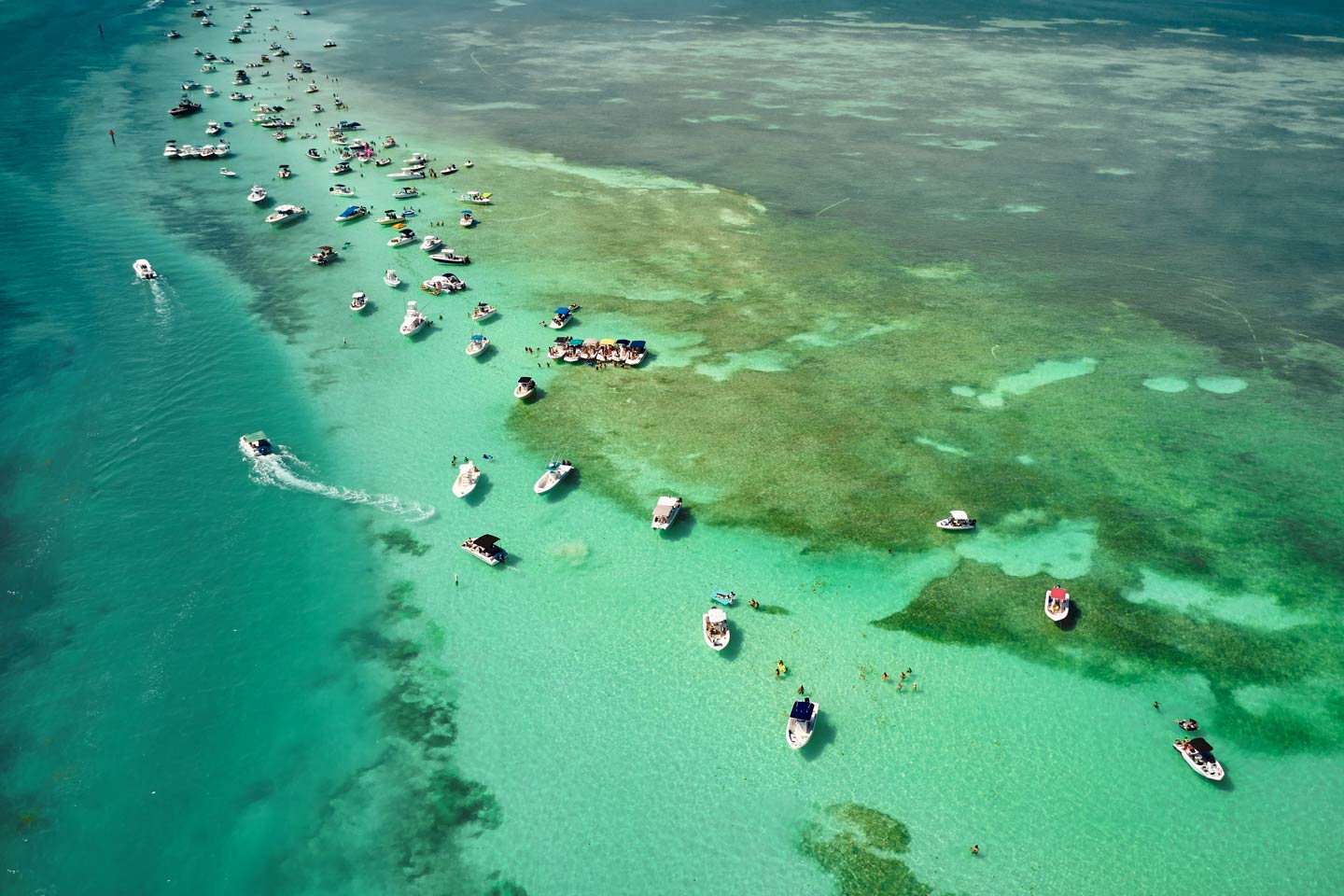
In this guide, we’ll talk about the gorgeous turtle grass and mangrove islands throughout the Keys where you can fly fish for the local angling trifecta. We’ll cover the who, where, when, and how of the local fly fishing scene. So, without further ado…
Why the Florida Keys?
There are many reasons why fly fishing in the Florida Keys is so popular. First of all, life is slower in the Keys. Ask any fly fisherman here, and they’ll tell you that you get to savor the world’s most precious gift – time. You don’t have to rush and fill your bucket with as many fish as possible. Fly fishing here offers you a deeper experience. It trains your patience and can easily humble you at any given moment, no matter your skill level and experience.
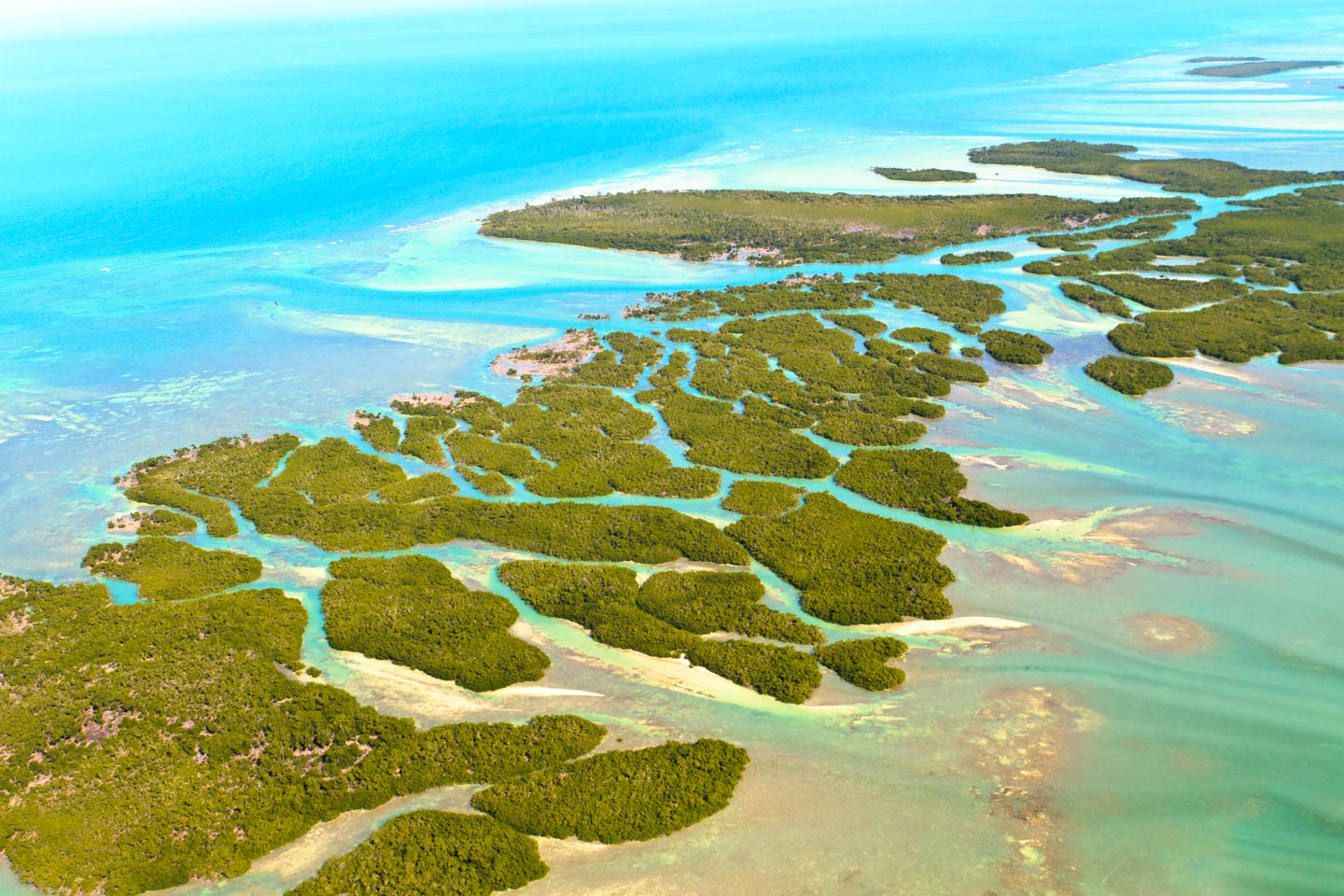
Thanks to its geographic isolation, the Florida Keys is a perfect mixture of history and tradition that welcomes beginners and seasoned veterans alike. You can start by sight fishing in the shallows and try your hand at different types of gear and flies. You’re also free to practice fishing for the likes of Snook and Redfish in the Everglades before you move to the Florida Grand Slam.
This craft is seriously valued here, no matter where you cast. Some say Key Largo is a perfect first stop for those who’ve never been to the Keys before. Others suggest starting with the Everglades National Park or looking for the Grand Slam in Cudjoe Key and Big Pine.
What can I catch fly fishing the Florida Keys?
As we mentioned above, fly fishing in the Florida Keys is essentially about pursuing the Big Three – Permit, Tarpon, and Bonefish – on the fly. Be it beginner anglers or seasoned veterans, everyone agrees that hunting these fish is highly addicting and can easily change you as an angler.
Keep in mind you can also fish for the likes of Redfish and Snook, along with Trout. These aren’t the most popular fly fishing targets, although they, too, are worthy opponents.

We should talk about each member of the Grand Slam in more detail. But before we start, there’s one important thing you need to remember. Permit, Tarpon, and Bonefish are strictly catch-and-release species. When (and if) you catch your target, you’ll need to put it back into the water safe and unharmed.
Permit
The single most important thing you need to know about fly fishing for Permit in the Florida Keys is that these beautiful fish are held in the highest regard. Permit are so hard to catch on the fly that even years of experience and the best equipment can’t guarantee a successful bite. In fact, even the best guides in the Keys can have only slightly over a dozen of catches a year.
And that’s the entire point. Permit in the Keys aren’t prolific, usually traveling in ones or twos. It’s not easy to spot them, and if you do, they’ll most likely run your line out. Permit will teach you to accept rejection and keep trying. With success so elusive sometimes, the challenge of catching Permit turns into a valuable experience.
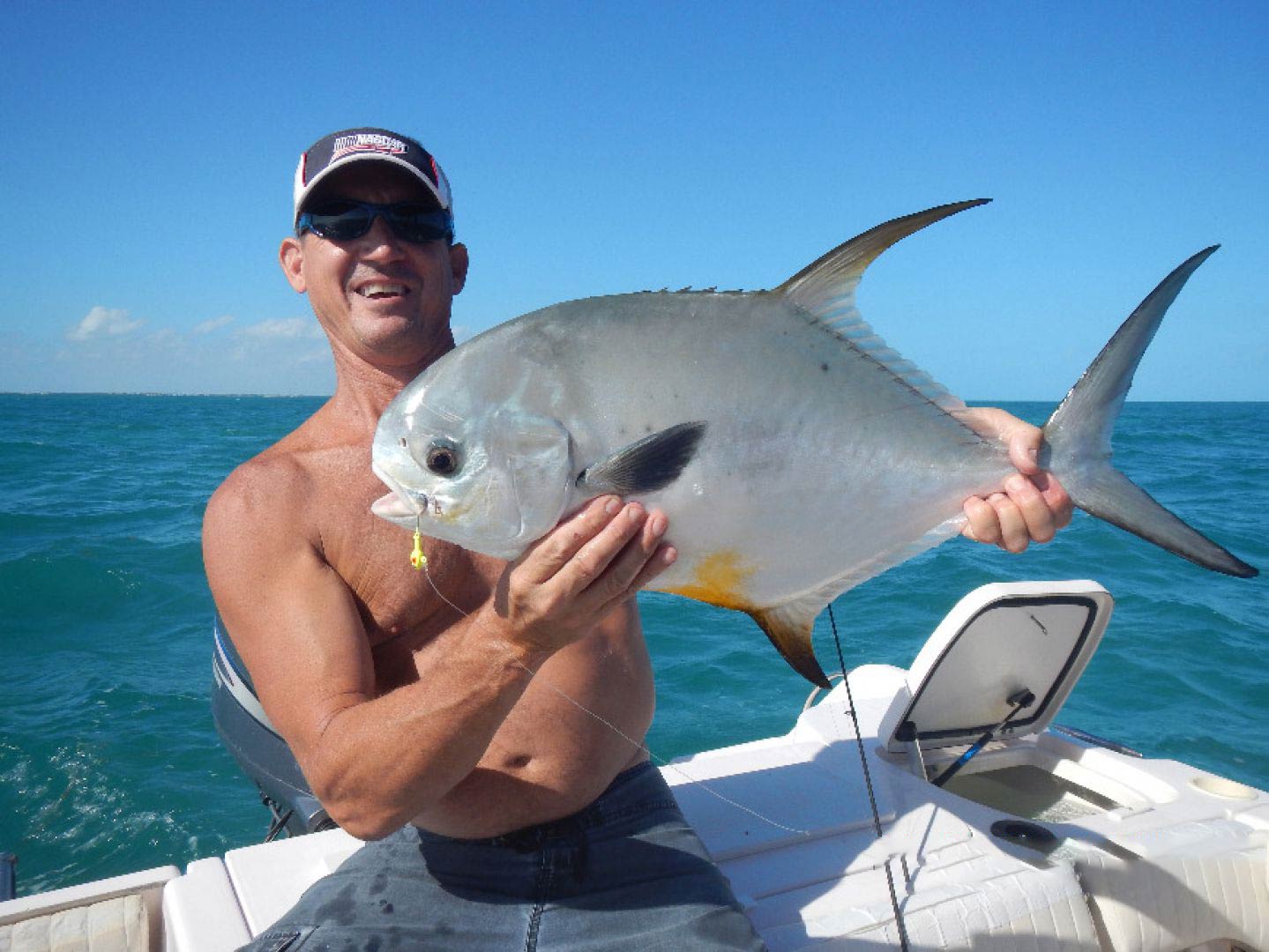
Fly fishing for Permit in the Keys is good year-round, while peak times depend on where exactly you’re fishing. Some guides supply their own Permit flies, leaders, and rods, so it’s never a bad idea to book a trip with an experienced local guide.
Before you hit the flats to pursue Permit, there are a couple of things to consider:
- Practice your casting in advance.
- Don’t give up, enjoy the process.
- Drop the fly right on the Permit’s head when you see it.
Tarpon
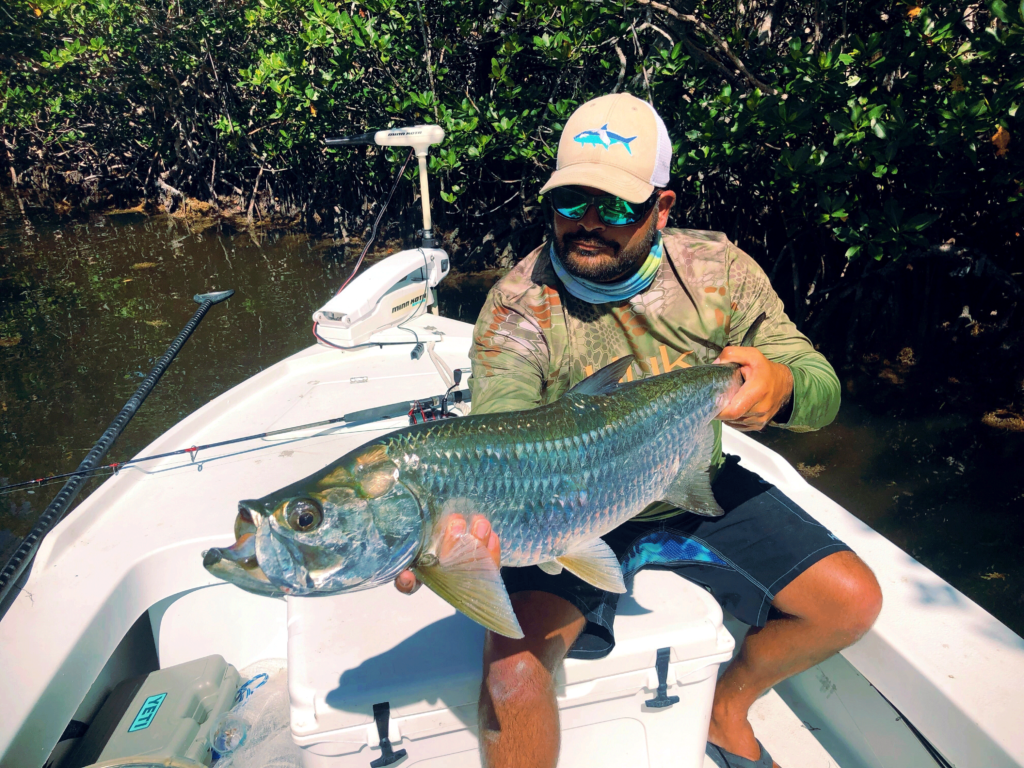
The Keys aren’t just a place to fly fish for the “Silver King”, they’re the place. Fly fishing for Tarpon and the Florida Keys are so intertwined they’re practically the same thing. Quite a few legendary fly anglers spent years perfecting their craft across the oceanside flats from Islamorada to Key West, and the tradition goes on today.
You can chase the resident Silver King in the backcountry of the Keys, around big basins, mangrove shorelines, and channel edges. In February and March, Tarpon begin to lay up around the banks and basins before heading to the beaches in late April.
In late spring, the beaches from Marathon Key to the Marquesas Keys are Tarpon runways. The annual migration attracts both locals and visitors from all over the country, eager to challenge big schools of Tarpon to a hard – but fair – battle.
Although some periods might be busier than others, fly fishing for Tarpon is good throughout the year.
Bonefish

Florida Keys Bonefish on the fly has a long history and a lot of world records. Just like Permit, these fish can humble absolutely any angler, even an experienced Bahamanian guide. Everyone knows that you need a lot of patience when fly fishing for Florida Keys Bonefish.
Since the local Bonefish are pretty big (around 4–6 pounds), they tend to eat big flies. If you’re lucky, you might even cast for a trophy or spot double-digit fish. Some of the best spots include the flats around the Middle Keys, Marathon, and the Big Pine Key, but you can look for Bonefish over backcountry and ocean flats of sand and turtle grass.
When’s the best time for a Bonefish fly fishing trip in the Keys? You can start by fishing backcountry in the spring, move to outgoing tides in the ocean flats in the summer, and head back to the backcountry in the fall. Anytime from March through November offers good chances to target Bonefish on the fly.
Where to go fly fishing in the Florida Keys?
Fly fishing grounds range from the Everglades National Park all the way to the Marquesas Keys 30 miles west of Key West. So, where’s the best fly fishing in the Keys? The short answer is, anywhere.
It all depends on what experience you’re looking for. You can score a Grand Slam in Marathon Key or Big Pine Key during the day and go partying that same evening. Some places are asleep right after the sunset, which is perfect if you’re looking for a quiet getaway.
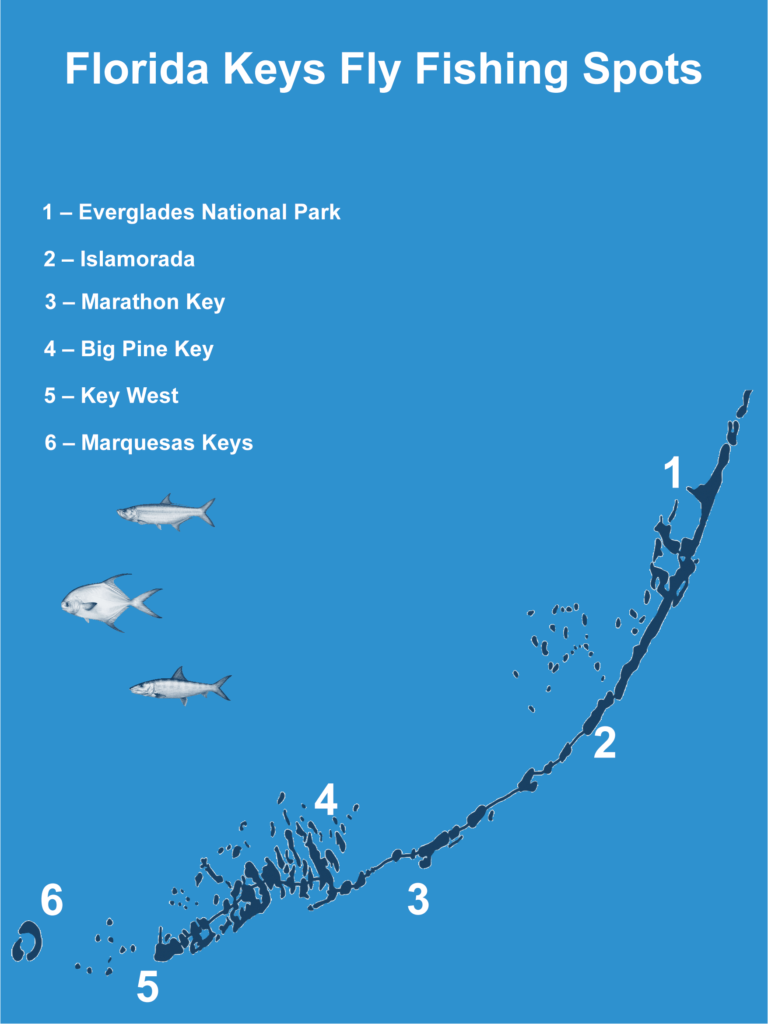
Here’s a list of our favorite Florida Keys fly fishing spots for you to consider:
- The Marquesas Keys. The western part of the Keys is arguably the best spot for winter fly fishing. There are lush turtle grass flats with Permit, Bonefish, and Tarpon. Summer is ideal for a morning trip after Permit for any who want the waters all to themselves. There isn’t much fishing pressure in the fall either, so anglers can fully enjoy the ocean-side flats of the Marquesas.
- Big Pine Key. The Lower Keys are known for their deeper basins and shallow flats that offer good chances to spot the Golden Trip year round. Then there’s the endless backcountry of Florida Bay, with miles of turtle grass flats and gorgeous beaches with coral heads. Many legendary fly fishermen visited Big Pine Key, especially Loggerhead, so why shouldn’t you?
- Marathon Key. A lot of local anglers would say that while Islamorada and Key West get all the glory, Marathon Key is sometimes overlooked. This allows you to enjoy much less fishing pressure paired with amazing fly fishing opportunities in the backcountry banks and Bonefish flats. Fishing for the Slam within sight of the Seven Mile and Bahai Honda bridges is pretty unforgettable.
- Islamorada. First of all, Islamorada has the Everglades National Park right in its backyard. You can hardly find a fly angler who would resist a trip to the Everglades’ backcountry! In fact, some say that saltwater fly fishing was born in Islamorada. It can easily spoil you with its many Tarpon, Bonefish, and Permit, although the list of potential fly fishing catches doesn’t end here. Redfish and Snook are also abundant in saltwater creeks of the Upper Keys.
- Key West. Anyone would agree that Key West is blessed with productive spots that seem almost magical. The hard coral flats, mangrove shorelines, and lush turtle grass offer year-round opportunities to catch Bonefish and Tarpon. However, Key West is mostly known for its Bonefish fly fishing action.
How to go fly fishing in the Florida Keys?
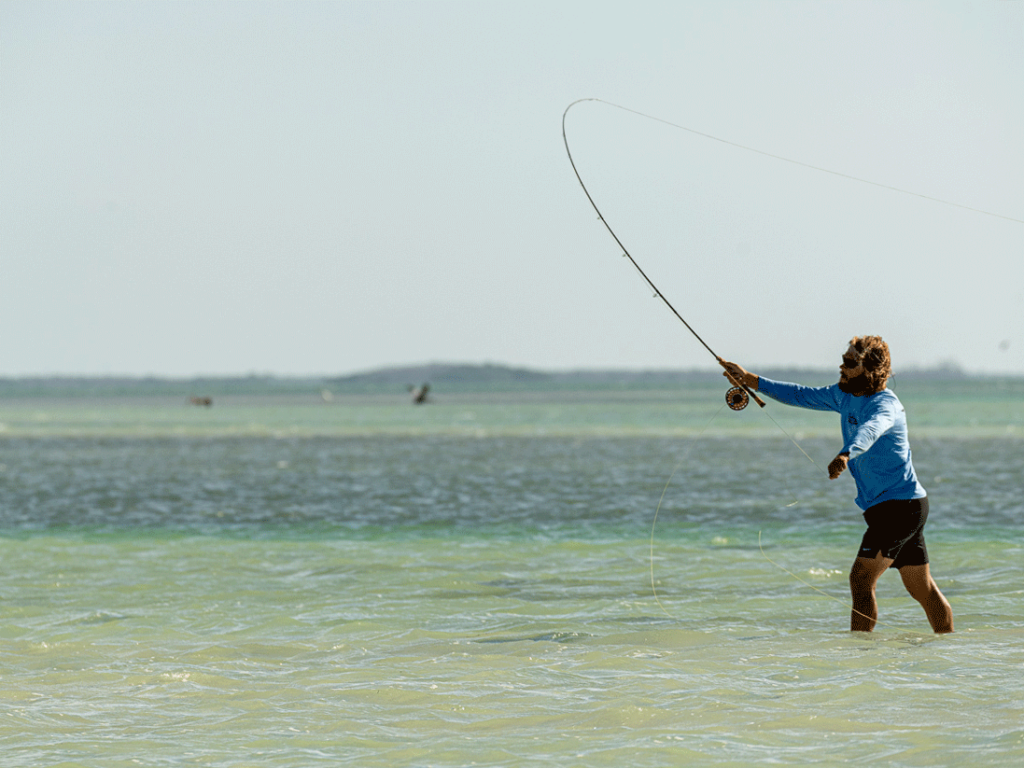
First of all, you need a lot of practice. Even if you’re a seasoned fly fisherman, consider booking a trip with a local guide. The Florida Keys are home to some of the legendary fly anglers that have spent decades mastering the craft. A lot of them offer guided trips, catering to all skill levels. Learning the art of fly fishing is much more effective if you have a professional by your side, especially if you’re a complete beginner.
Fly Fishing for Tarpon

When picking tackle for your Tarpon fly fishing trip, opt for heavier options. Locals use a bigger “Tarpon rod,” an 11–12 weight fly outfit. This is usually paired with fluorocarbon leaders and clear sink tip lines. You might need a saltwater reel with a smoother working and heavy-duty drag, along with a minimum of 300 yards of backing line.
Color and weight are crucial when it comes to Tarpon flies. A good rule of thumb is picking a color with good contrast with the bottom of the flats. For example, orange, yellow, and red patterns work for sandy bottoms, while blue and green are perfect for grass.
The majority of Tarpon anglers in the Keys might tell you that you need to figure out how to play the fish. It’s essential to keep a lot of pressure on the rod while targeting the Silver King and keep the fish off balance, working from side to side.
Fly Fishing for Bonefish
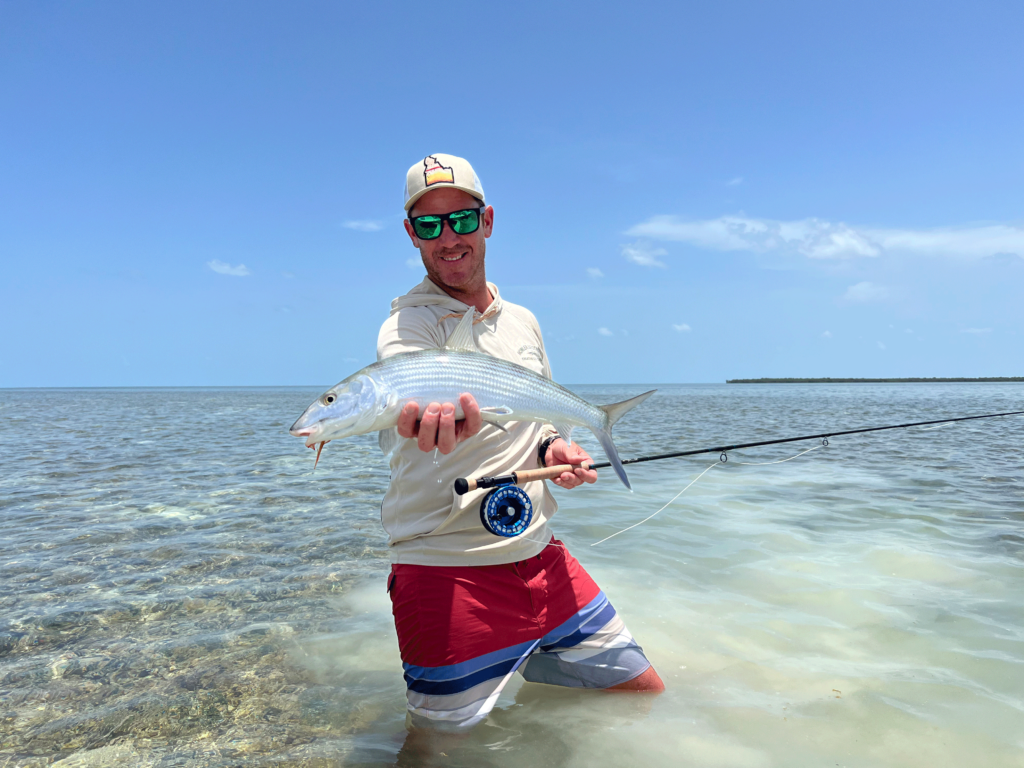
As you already know, Bonefish are tricky to catch and spook easily. There are some tricks that might help, although the catch is never really guaranteed.
Firstly, you need to cast from the side, using lighter gear. While you need a heavier rod for Tarpon, an 8–9 weight rod usually does the trick for Bonefish. A lot of the more experienced anglers go even lighter than this, fishing with 4–5 weight rods. You also need a saltwater reel, fluorocarbon leaders, and at least 200 yards of clear or floating lines.
It goes without saying that Bonefish are picky. Baitfish patterns in sizes #1 to #4 work well, although it’s important to pick the right color and weight. It’s always a good idea to tailor the weight to match the depth you’re fishing and avoid wearing bright colors to not spook the fish.
Finally, keep an eye on the tides. The most ideal scenario is casting from high tide on an ongoing tide.
Fly Fishing for Permit
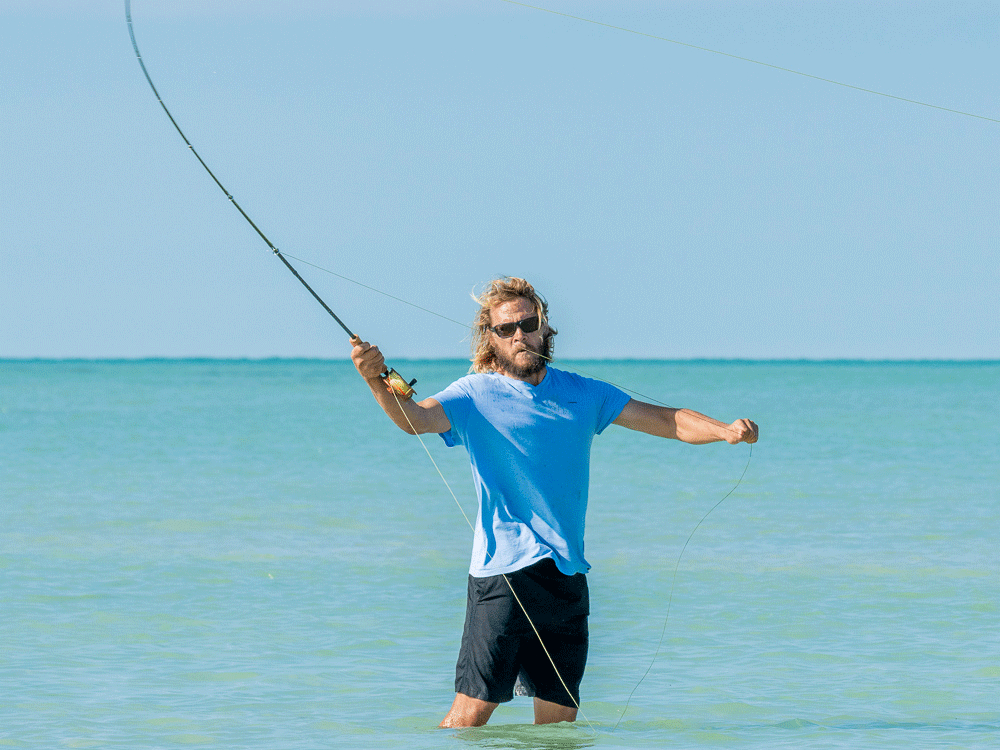
When it comes to precision and presentation, fly fishing for Permit is no different. A 9–10 weight rod can serve you well even in windy conditions. Locals use fluorocarbon leaders ranging from 9 to 12 feet with up to a 20 lb test. Some juggle between clear or floating lines and clear sink tips.
The Permit flies are usually heavily weighted, ranging from #1 to #2. The usual arsenal includes a variety of crab and shrimp patterns, along with merkins and toads. However, some anglers tend to gatekeep their choice of Permit flies, and we can’t judge them for that. The best thing you can do to increase your chances is to trust your guide!
Frequently Asked Questions
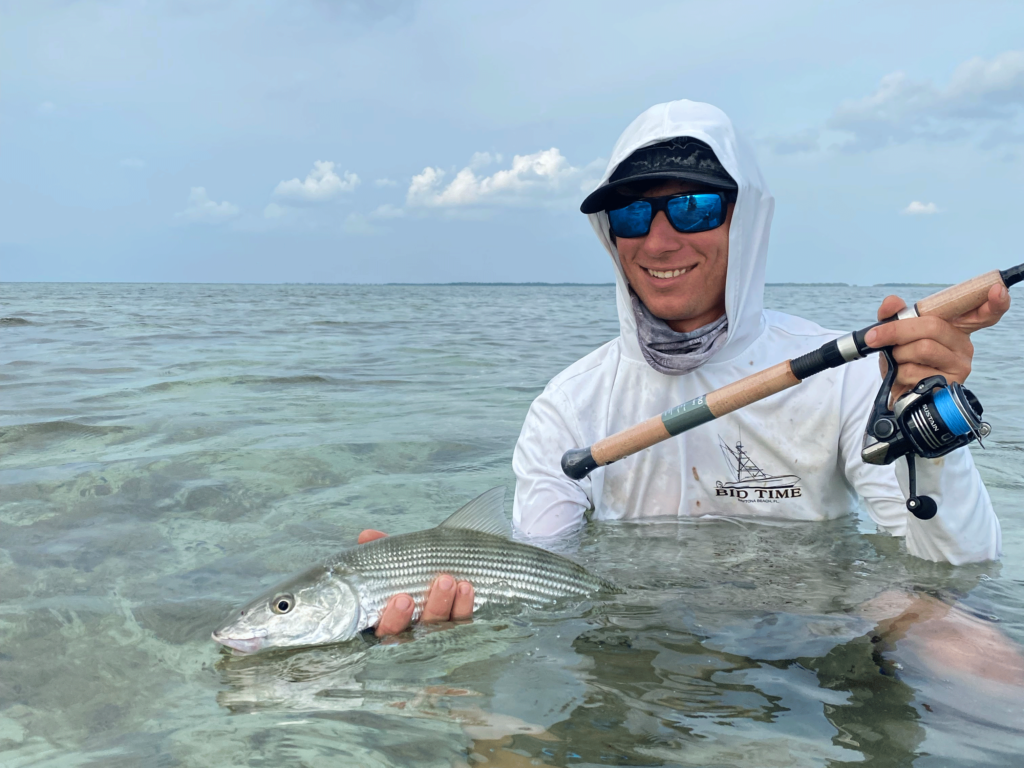
- Do I need a fishing license to go fly fishing in the Keys?
All anglers aged 16 and over need to have a valid Florida fishing license. However, you won't need one if you're fishing with a licensed captain/guide. Feel free to learn more about it here.
- Can I keep the catch?
Anglers treat the Florida Keys flats and backcountry as a catch-and-release fishery for a good reason. To help the fishery thrive, most of the waters are protected in National Marine Sanctuary Zones. Bonefish and Tarpon are strictly catch-and-release, while Permit are subject to special regulations. You can consult the FWC website for more information.
- When to go fly fishing in the Florida Keys?
You can catch Tarpon, Bonefish, and Permit all year round, although there are periods when specific fish are more abundant. For example, Tarpon season peaks in April and May, while Permit and Bonefish bite best in the first signs of spring and fall.
- Is fly fishing in the Keys kids-friendly?
Children can enjoy fly fishing as much as adults, if not more. While experience matters when fly fishing, you need to start somewhere. A lot of guides welcome younger anglers to learn the art of sight casting on the Florida Keys flats.
- Are there any fly fishing tournaments?
There are multiple fly fishing tournaments in the Keys throughout the year. Islamorada hosts Backcountry Fly Championship Series for Snook and Redfish a couple of times a year, along with a mixed bag Casting for Cats Women's Backcountry Tournament event. Key West hosts March Merkin Permit and Del Brown Permit Tournaments. Tarpon anglers can take part in Golden Fly Invitational Tarpon Tournament, Don Hawley Invitational Tarpon Tournament, Annual Ladies Tarpon Fly Tournament, and Annual Gold Cup Tarpon Tournament.
Fly Fishing Florida Keys – The Art of Elegance
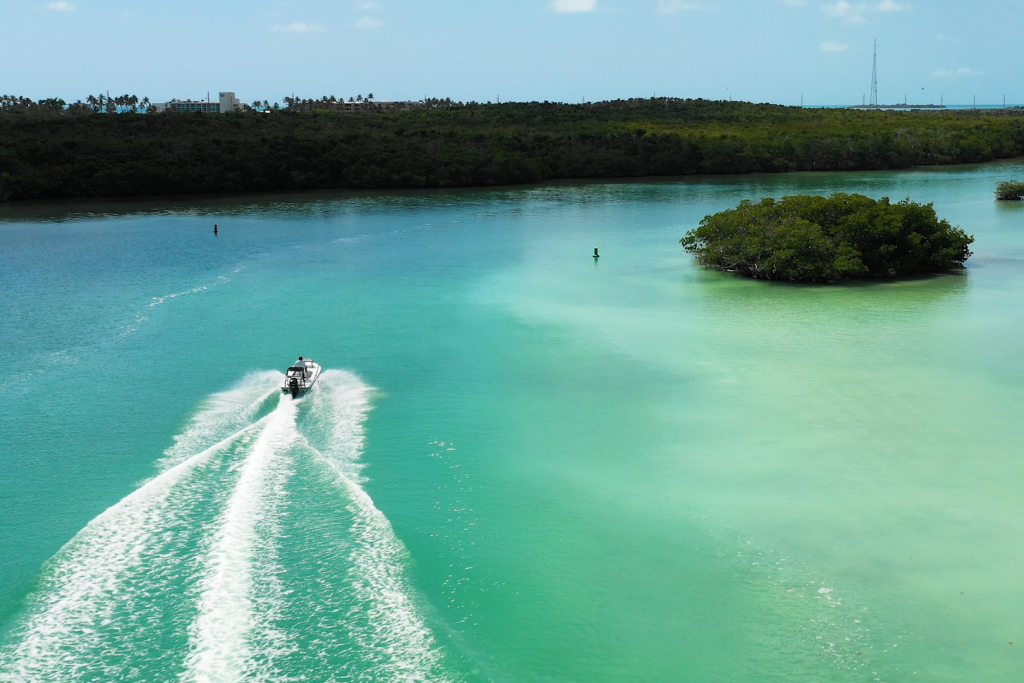
It doesn’t matter what got you hooked. It can be that successful cast to a tailing Permit or your first leaping Tarpon. What matters is that fly fishing in the Florida Keys is the best in the country, if not the world. It’s challenging, technical, and always intense. But it’s never boring, and the reward is always worth it. In fact, come down to the Keys at least once and you may find yourself wishing you could stay forever.
There you have it. Have you ever been fly fishing in the Florida Keys? Where did you go? What is your most memorable catch? Let us know in the comments below.
The post Fly Fishing in the Florida Keys: The Complete Guide appeared first on FishingBooker Blog.
https://ift.tt/kSE0sYI
0 Comments
Enregistrer un commentaire